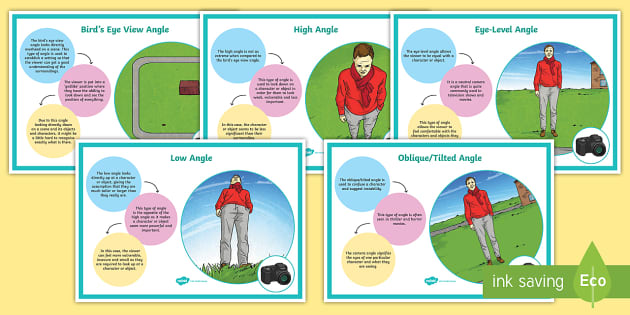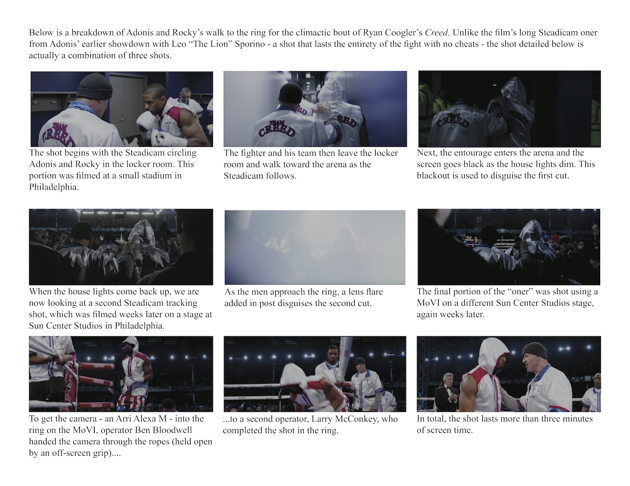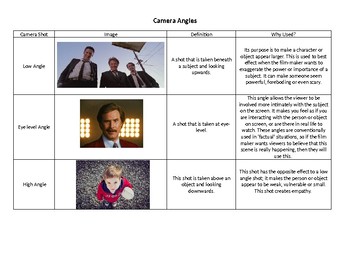Camera angles refer to the position of the camera relative to the subject being filmed. Different camera angles can have a significant impact on the way a scene is perceived by the audience, and filmmakers can use them to create a specific mood or convey a certain message.
One common camera angle is the eye-level angle, which is shot from the same height as the subject's eyes. This angle creates a sense of realism and makes the audience feel as if they are in the same space as the subject. It is often used in dialogue scenes to create a sense of intimacy and connection between the characters.
Another camera angle is the high angle, which is shot from above the subject. This angle makes the subject appear small and powerless, and can be used to convey a sense of vulnerability or insignificance. It is often used in action scenes to make the subject appear more vulnerable to the viewer.
The low angle, on the other hand, is shot from below the subject, making the subject appear larger and more powerful. This angle can be used to create a sense of dominance or to portray the subject as an intimidating or formidable presence. It is often used in action scenes to make the subject appear more formidable.
The birds-eye view is shot from directly above the subject, giving a top-down perspective. This angle can be used to give the audience a broad overview of the scene or to highlight the layout of a location. It is often used in action scenes to show the relationships between characters and their surroundings.
Finally, the point-of-view shot is filmed from the perspective of a specific character, as if the audience is seeing through their eyes. This angle can be used to create a sense of empathy and to allow the audience to experience the scene from a character's perspective.
In conclusion, camera angles are an important element of filmmaking that can significantly affect the way a scene is perceived by the audience. By choosing the right camera angle, filmmakers can convey a specific mood or message and create a more immersive and engaging viewing experience.
22 Types of Camera Shots & Angles to Use in Film & Photography

As a filmmaker, understanding the importance of camera angle shots in telling a story is integral to placing the audience in the right frame of mind and emotion. Low angle shots work really well for fashion videos, where you want to show the subject as powerful and intense, as well as in travel videos to enhance certain architectural elements. The camera is placed behind the character who is listening — so you can see part of the head and the shoulder. The long shot also shows the full length of the subject, so can be useful in exaggerating scale when comparing the subject to the objects surrounding it. A film-maker may use this to make us feel extra comfortable or extremely uncomfortable about a character, and usually uses a zoom lens in order to get the required framing. Eye Level The eye-level shot is typically used to create a sense of sympathy for the character being focused on during the particular scene. There are no rules regarding camera angle for this genre, except that the images should be as striking as possible.
The Best Camera Angles for Different Sports

Reaction shot You probably don't need much of an introduction to this shot — it's a shot framed to show the character's reaction to the specific action. In a long shot, the person is in the middle distance, with plenty of room overhead and below the feet. The subject may not take up the whole width of the frame, especially if you only have one character in the shot, since this is as close as we can get without losing any part of the subject. An excellent recent example of using the long shot is in the 2017 superhero movie Wonder Woman. Final Words Now that you have an overview of the shot captures you can make, which ones do you plan to use? Profile shots are flat, whether a distant car traveling parallel to the camera or a subject walking across a room. Wrapping up While your core story will always be at the heart of the videos that you create, knowledge of different camera angles can go a long way in pushing forth your intended narrative goal.
Camera Angles & Actions

What camera angle is best? The Quentin Tarantino flick Kill Bill Vol. The more extreme the angle ie the further away it is from eye left , the more symbolic and heavily-loaded the shot. This technique ensures that the most important information makes it to the audience. In a Dutch angle shot, the filmmaker sets up the camera so that it tilts diagonally, giving the entire scene a disorienting, off-kilter look that suggests that something has gone wrong. Looking at someone at eye-level also shows them to be an equal. You'll see this use of the high angle shot in many film noir. However, better and more affordable drones are popping up, and they work perfectly in getting your aerial shot just right.
How to Spotlight the Projects by Different Camera Angles? • AIMIR CG

For instance, a close shot may be a medium closeup, a closeup, a big or tight closeup or an extreme closeup. This type of shot is close enough to the subject that you can still see emotions and expressions — but you can also show part of the scene, especially what they are doing with their hands. But one of the most important and often overlooked components is the scene composition, which in itself is dependent on how you frame your shots and the angle at which the camera is placed. Tilts A movement which scans a scene vertically, otherwise similar to a pan. Watch for the light, too.
Camera Angles

Like, when the rescuing hero runs desperately toward the lens, yet runs and runs and runs without seeming to get any closer. This is often used at the beginning of a film, in order to establish setting and movement. Be intentional when you select your shots. Remember when Kevin from Home Alone runs away from the creepy older man in the supermarket spoiler alert — it turns out he's a sweetheart? How close or far your subject is to your camera — your shot size — will underscore how the audience should feel about it or them. By contrast, rear angles — especially on people — feel closed off from viewers. While it is close enough to see their faces, it also captures the characters' body language while showcasing the subject's environment without the audience getting disoriented. Also, because falling is an unsettling experience, off-level setups can add a subtly queasy, creepy feeling to a shot.
10 Different Types of Camera Shot Angles in Film (With Examples)

Low Angle The low-angle shot conveys the power or dominance of the subject character in the scene. Medium shots Midrange angles, including full shot to medium closeups, tend to be inconspicuous because they model typical human perspectives. Facing seemingly insurmountable odds, the long shot conveys her determination through facial emotion and body language. When that happens, the audience should be able to take it all in — everything she's feeling in that very moment. High angles, especially overhead shots, are excellent for food photography, showing off everything on the plate or in the dish and helping to keep distractions out of the background.








